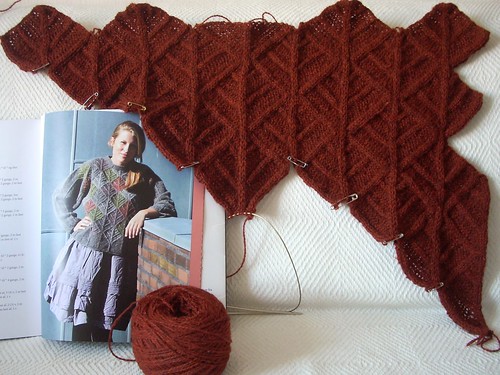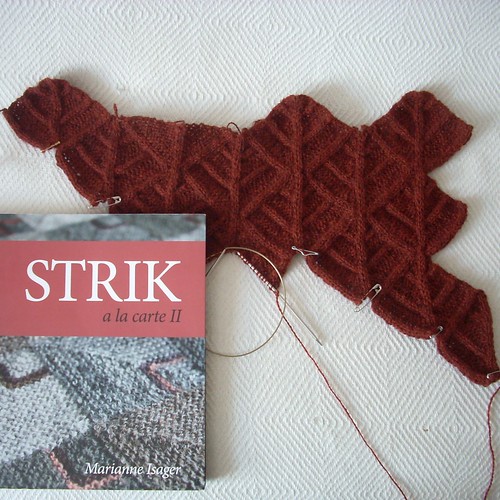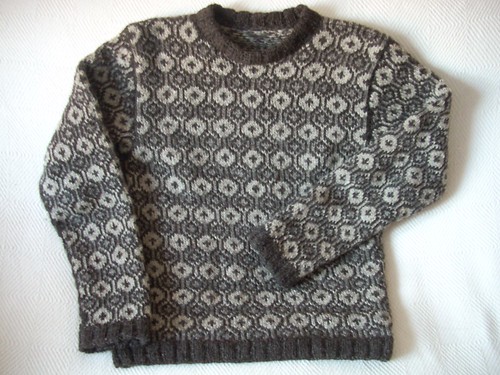You get a different effect knitting Marianne Isager's design with a single colour. In her original sweater there is more focus on the shape of the individual mitred squares, while my version will emphasise the overall effect of the combination of them: panels rather than squares, since the vertical lines stand out.
I like both of them, so I might make another one similar to the sweater in the book some day. Isn't fascinating what a difference even a minor change of colour(s) can make?
Thursday, 28 March 2013
Thursday, 21 March 2013
Domino sweater in progress
There have been unusually many joys of knitting lately: all your comments on the Faroese sweaters make me very happy, I had a great weekend on the west coast as a workshop leader (twined knitting and lace patterns) and Marianne Isager's latest book arrived. She's one of my idols, so my expectations were high - and I was definitely not disappointed.
I've cast on to knit one of the sweaters, a design that consists of domino squares where you combine garter stitch and slipped stitches. The yarn is 2ply wool from Kampes, which I also use to knit the "spede" sweater I mentioned in my previous post.
Those sweaters are meant to be short and tight, and it's fun knitting a different sweater shape. The star pattern will cover the back and the sleeves, but not the front. Let's call it the bosom factor: the sweater is so tight that quite a few increases are necessary, and that would ruin the pattern. Therefore, the stars are in panels only with a stocking stitch area in the middle where all the increases are. This was not my own idea, but I got it from a 19th century sweater in a book I borrowed from Anna, who will get the sweater. Fortunately for me she will take care of the decorations once it's finished! Here is a beautiful example of a sweater made by Tålamodspåsen - who is more than capable of taking care of every single detail herself.
När bystfaktorn är hög gäller det att tänka efter innan man börjar med framstycket till en spedetröja. De ska ju vara korta och åtsittande, så det var nödvändigt att ha en hel del ökningar samtidigt som dessa skulle förstöra stjärnmönstret - och en slätstickad tröja är uteslutet. (Och då fuskar jag redan genom att ha alldeles för tjocka stickor för en riktig spedetröja. Hur tjocka? 2,25 mm.) I en bok jag har lånat finns det exempel på tröjor med ett slätstickat parti mitt fram där ökningarna ligger, så den lösningen knyckte jag med gott samvete.
Mitt andra (dvs senast tillagda) tröjprojekt är ett mönster ur Marianne Isagers senaste bok. Det är rätt roligt att lägga ruta till ruta, och jag tycker att effekten blir så fin med de vertikala linjerna som går mitt i rutorna. Till båda tröjorna har jag valt Kampes tvåtrådiga, och jag har skaffat det på Litet nystan i Stockholm.
I've cast on to knit one of the sweaters, a design that consists of domino squares where you combine garter stitch and slipped stitches. The yarn is 2ply wool from Kampes, which I also use to knit the "spede" sweater I mentioned in my previous post.
Those sweaters are meant to be short and tight, and it's fun knitting a different sweater shape. The star pattern will cover the back and the sleeves, but not the front. Let's call it the bosom factor: the sweater is so tight that quite a few increases are necessary, and that would ruin the pattern. Therefore, the stars are in panels only with a stocking stitch area in the middle where all the increases are. This was not my own idea, but I got it from a 19th century sweater in a book I borrowed from Anna, who will get the sweater. Fortunately for me she will take care of the decorations once it's finished! Here is a beautiful example of a sweater made by Tålamodspåsen - who is more than capable of taking care of every single detail herself.
När bystfaktorn är hög gäller det att tänka efter innan man börjar med framstycket till en spedetröja. De ska ju vara korta och åtsittande, så det var nödvändigt att ha en hel del ökningar samtidigt som dessa skulle förstöra stjärnmönstret - och en slätstickad tröja är uteslutet. (Och då fuskar jag redan genom att ha alldeles för tjocka stickor för en riktig spedetröja. Hur tjocka? 2,25 mm.) I en bok jag har lånat finns det exempel på tröjor med ett slätstickat parti mitt fram där ökningarna ligger, så den lösningen knyckte jag med gott samvete.
Mitt andra (dvs senast tillagda) tröjprojekt är ett mönster ur Marianne Isagers senaste bok. Det är rätt roligt att lägga ruta till ruta, och jag tycker att effekten blir så fin med de vertikala linjerna som går mitt i rutorna. Till båda tröjorna har jag valt Kampes tvåtrådiga, och jag har skaffat det på Litet nystan i Stockholm.
Thursday, 7 March 2013
Faroese sweater finished
First of all, thanks for your kind words about the Faroese sweater I've been working on! It is finished and delivered (a birthday present) and the size was just right. It was a lot of fun to knit too, and the only negative thing about the project was the smell that spread through the rooms when I washed it - it was like living in an old barn. (I grew up in the country, so I'm familiar with the smell.)
Ron asked about the armhole, whether I bind off some stitches at the bottom and then more as I go up. Not quite, but almost: instead of binding them off I put them on a thread. That makes it easy to add them to the stitches I pick up to knit the sleeves - and it's more comfortable too as there's no ridge. On the following rows I did some more decreases, partly for comfort and partly to make it look nice, to avoid amputated repeats, so to speak.
To avoid jogs in the pattern I added narrow side panels: this way all rows start with the same colour, and it is possible to continue the pattern along the sleeve and place the sleeve decreases on each side of it.
Carolina asked if I calculate in detail beforehand to make sure the pattern comes out right. Not really - or not anymore, I should say. Too eager to start knitting I do a rough calculation and then trust a combination of luck and experience!
Jules asked if short-row armscyes would work for an Alice Starmore sweater. I'm sure it would! The tricky thing is doing short rows with two colours, finding the right places for the wraps. There's a risk that light-colour wraps around a dark stitch will show glaringly, so I make sure they're the same colour. It's a pity if the wraps draw attention to themselves instead of being as invisible as possible.
I've cast on to make a traditional Swedish spedetröja. Traditional in the sense that I use the traditional shape and a common kind of star pattern from the period (late 1800s) but it's not a copy of an existing garment. This sweater is for Anna, who teaches dances from the 1700s. Next lesson is tonight - highlight of the week!
Ron asked about the armhole, whether I bind off some stitches at the bottom and then more as I go up. Not quite, but almost: instead of binding them off I put them on a thread. That makes it easy to add them to the stitches I pick up to knit the sleeves - and it's more comfortable too as there's no ridge. On the following rows I did some more decreases, partly for comfort and partly to make it look nice, to avoid amputated repeats, so to speak.
To avoid jogs in the pattern I added narrow side panels: this way all rows start with the same colour, and it is possible to continue the pattern along the sleeve and place the sleeve decreases on each side of it.
Carolina asked if I calculate in detail beforehand to make sure the pattern comes out right. Not really - or not anymore, I should say. Too eager to start knitting I do a rough calculation and then trust a combination of luck and experience!
Jules asked if short-row armscyes would work for an Alice Starmore sweater. I'm sure it would! The tricky thing is doing short rows with two colours, finding the right places for the wraps. There's a risk that light-colour wraps around a dark stitch will show glaringly, so I make sure they're the same colour. It's a pity if the wraps draw attention to themselves instead of being as invisible as possible.
.jpg) |
| shoulder join and sleeve cap |
I've cast on to make a traditional Swedish spedetröja. Traditional in the sense that I use the traditional shape and a common kind of star pattern from the period (late 1800s) but it's not a copy of an existing garment. This sweater is for Anna, who teaches dances from the 1700s. Next lesson is tonight - highlight of the week!
 |
| 2ply wool from Kampes; 2.25 mm needles (US 1) |
Subscribe to:
Comments (Atom)




.jpg)
.jpg)